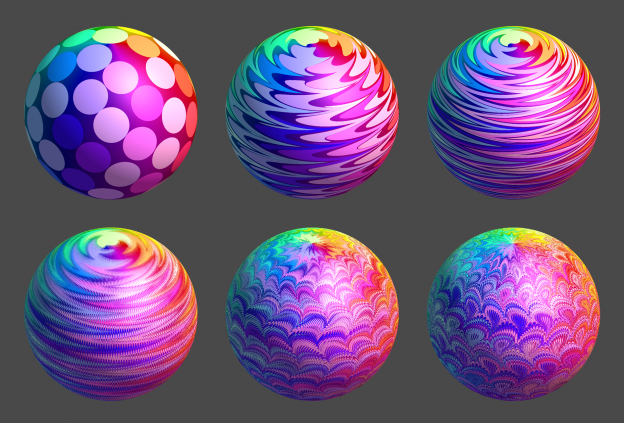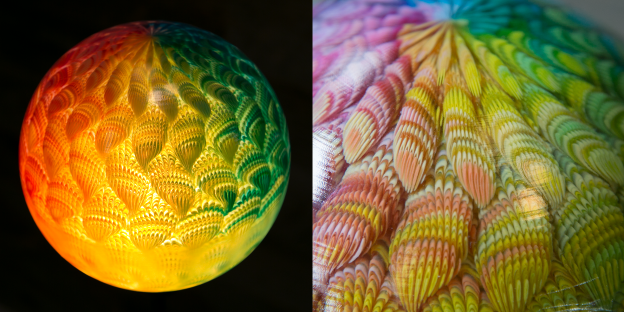I visited Italy several times as a young child and was fascinated by the Italian technique of paper marbling. I begged my parents to buy me the marbled-paper-covered notebooks and pencils sold in Italian stationery stores.
Fast-Forward a Few Decades...
We have a Stratasys J750, and I’m excited to play with GrabCAD Voxel Print. The power to control full-color prints at the voxel level is too cool to pass up. I wanted to recreate the marbled paper aesthetic using math, in the form of a spherical light fixture. After studying this video of a Florentine artisan making marbled paper, I broke the technique down into discrete steps which could be replicated as a custom GLSL slicer:
- Drip circles of color evenly over your surface.
- Stretch everything out in alternating, low-frequency horizontal stripes.
- Run a high-frequency comb vertically.
- Run two low-frequency combs vertically with a sine wave offset. This creates the classic “pavone” style, which is Italian for “peacock”.

A surface shader visualizing the steps in sequence.
The J750 can print in VeroClear, so I decided to add a clear-coat and use fewer opaque voxels for better translucency. Then I realized I could vary the depth of the opaque voxel layer to create a 3d texture, increasing the depth with each pass of the "combs." We don’t yet have a good way to visualize voxels in 3D, so I modified my surface shader to get an idea of what it might look like:

Left: White is near the surface. Black is near the inner radius of the hollow sphere.
Right: A closeup of the actual voxels from one slice. It’s mostly VeroClear (light grey).
Print 20cm Diameter Spheres!
I’ve printed some as two hemispheres that snap together, and one as a full sphere:

This one is 5mm thick and was printed as two hemispheres, which is good for support removal. It requires no polishing since the bottom half can be printed upside down. However you can see the seam at the equator, which bugs me.

This iteration is 2cm thick and was printed as a complete sphere. It took 68 hours to print and nearly maxed out the height of the J750’s build volume. I still need to polish the bottom half.
Voxel Printing is an exciting and intimidating medium for artistic expression. The inherent flexibility and repeatability can make it feel like a design will never be completed. It’s just too much fun to tweak a variable for the next print. I'm currently working on a new variation that’s halfway between these two.






